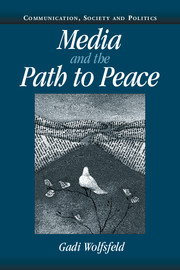Book contents
- Frontmatter
- Contents
- Acknowledgements
- Introduction
- 1 Building theory
- 2 The initial stages of Oslo
- 3 The Israeli media and the debate over Oslo
- 4 The Palestinians and the Israeli media
- 5 The media and the Israel–Jordan peace process
- 6 The media and the struggle for peace in Northern Ireland
- 7 The collapse of Oslo and the return to violence
- Conclusion
- Methodological appendix
- References
- Index
5 - The media and the Israel–Jordan peace process
Published online by Cambridge University Press: 22 September 2009
- Frontmatter
- Contents
- Acknowledgements
- Introduction
- 1 Building theory
- 2 The initial stages of Oslo
- 3 The Israeli media and the debate over Oslo
- 4 The Palestinians and the Israeli media
- 5 The media and the Israel–Jordan peace process
- 6 The media and the struggle for peace in Northern Ireland
- 7 The collapse of Oslo and the return to violence
- Conclusion
- Methodological appendix
- References
- Index
Summary
This chapter departs from the previous ones in three important ways. First, the peace process between Jordan and Israel was very different than Oslo. It was shorter, more congenial, and ultimately more successful. Second, the fact that a formal peace agreement was signed between the two countries allows us to explore the role of the news media in building peace after such accords have been signed. Finally, this part of the study also includes evidence taken from a very different type of media environment. Collaboration with a Jordanian counterpart provided important insights about the values and routines that were adopted by the Jordanian journalists during this period and about changes in coverage of Israel.
As always, it is important to begin this analysis by considering the political environment surrounding the peace process. Jordan and Israel have always had a rather complex and unusual relationship that differs from Israel's relations with other Arab states or peoples. Although the countries fought two wars against each other (1948 and 1967) and a war of attrition in the period 1968–70, both maintained back-door communication and cooperation channels, especially during times of crisis. Each country had its own reasons for maintaining this tacit understanding.
Jordan's attitude towards Israel can be better understood within the context of Jordan's regional and global priorities (Abu-Odeh, 1999).
- Type
- Chapter
- Information
- Media and the Path to Peace , pp. 137 - 157Publisher: Cambridge University PressPrint publication year: 2004



